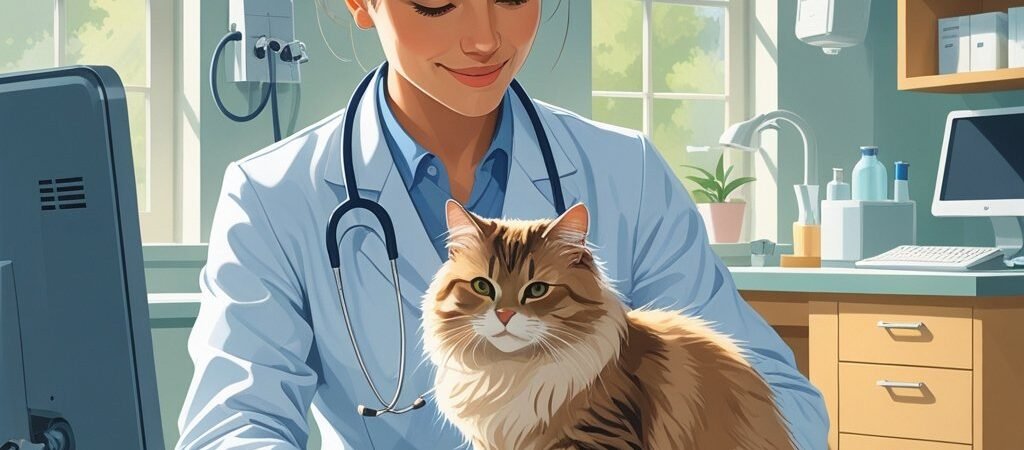Meta Description: Learn about the most common cat health problems and how to prevent them. Expert tips for keeping your feline friend healthy, spotting warning signs, and providing preventive care.
As devoted cat parents, one of our greatest concerns is keeping our feline companions healthy and happy throughout their lives. While cats are generally resilient creatures with strong survival instincts, they can be masters at hiding illness and discomfort, making it challenging to detect health problems before they become serious.
Understanding the most common health issues that affect cats, along with their warning signs and prevention strategies, empowers you to provide the best possible care for your feline friend. Early detection and preventive measures can often mean the difference between a minor health hiccup and a major medical crisis.
From obesity and dental disease to more serious conditions like kidney disease and diabetes, cats face various health challenges throughout their lives. However, many of these problems are preventable or manageable with proper care, regular veterinary attention, and educated pet ownership.
Let’s explore the most common health problems affecting cats today and discover practical, proven strategies for prevention that will help your cat live a longer, healthier, and more comfortable life.
1. Obesity: The Growing Epidemic in House Cats
Obesity has become one of the most prevalent health problems affecting domestic cats, with studies showing that over 50% of pet cats are overweight or obese.
Why Obesity is Dangerous
Excess weight puts tremendous strain on your cat’s organs and joints, leading to:
- Diabetes mellitus – overweight cats are 3-5 times more likely to develop diabetes
- Arthritis and joint problems – extra weight stresses joints and reduces mobility
- Heart disease – obesity increases cardiac workload and blood pressure
- Fatty liver disease – particularly dangerous when overweight cats lose weight too quickly
- Breathing difficulties – excess weight can compromise respiratory function
Prevention Strategies
Portion Control: Measure food portions rather than free-feeding. Most adult cats need only 20-30 calories per pound of body weight daily.
High-Quality Diet: Choose foods with high protein content and avoid fillers and excessive carbohydrates.
Regular Exercise: Engage your cat in 10-15 minutes of active play twice daily using interactive toys, laser pointers, or feather wands.
Environmental Enrichment: Create opportunities for natural movement through cat trees, puzzle feeders, and hunting games.
Regular Weigh-Ins: Monitor your cat’s weight monthly and body condition score to catch weight gain early.

2. Dental Disease: The Silent Destroyer
Dental problems affect over 70% of cats by age three, making oral health one of the most overlooked aspects of feline care.
Common Dental Issues
Periodontal Disease: Bacteria buildup causes gum inflammation, tooth loss, and can spread infection to other organs.
Tooth Resorption: A painful condition where the tooth structure breaks down, requiring extraction.
Gingivitis: Gum inflammation that, if untreated, progresses to more serious periodontal disease.
Warning Signs
- Bad breath (beyond normal “fish breath”)
- Difficulty eating or dropping food
- Pawing at the face or mouth
- Red, swollen, or bleeding gums
- Yellow or brown tartar buildup on teeth
- Excessive drooling
Prevention Methods
Regular Dental Cleanings: Professional cleanings under anesthesia every 1-2 years as recommended by your veterinarian.
Daily Tooth Brushing: Gradually introduce tooth brushing using cat-specific toothpaste (never human toothpaste).
Dental Treats and Toys: Use veterinary-approved dental chews and toys designed to reduce tartar buildup.
Diet Considerations: Some prescription dental diets are formulated to help reduce tartar through mechanical action.
3. Urinary Tract Problems: A Serious Concern
Urinary issues are among the most common reasons cats visit emergency veterinarians and can be life-threatening if not treated promptly.
Types of Urinary Problems
Urinary Tract Infections (UTIs): Bacterial infections more common in older cats and those with diabetes.
Feline Lower Urinary Tract Disease (FLUTD): An umbrella term for various conditions affecting the bladder and urethra.
Urinary Blockages: More common in male cats, this is a medical emergency requiring immediate treatment.
Bladder Stones: Mineral formations that can cause pain and blockages.
Prevention Strategies
Adequate Water Intake: Ensure multiple fresh water sources and consider water fountains to encourage drinking.
High-Quality Diet: Feed diets that promote urinary health and maintain proper pH levels.
Stress Reduction: Minimize stressful situations and provide environmental enrichment to reduce stress-related urinary issues.
Clean Litter Boxes: Maintain multiple, clean litter boxes to encourage regular elimination.
Regular Monitoring: Watch for changes in urination habits, frequency, or appearance.
Warning Signs Requiring Immediate Attention
- Straining to urinate with little or no urine produced
- Blood in urine
- Crying or vocalization while urinating
- Urinating outside the litter box
- Lethargy and loss of appetite
4. Kidney Disease: The Silent Killer
Chronic kidney disease affects approximately 30-50% of cats over 15 years old and is one of the leading causes of death in senior cats.
Understanding Kidney Disease
Acute vs. Chronic: Acute kidney injury happens suddenly and may be reversible, while chronic kidney disease develops slowly and is progressive.
Early Detection Challenges: Cats can lose up to 75% of kidney function before showing obvious symptoms.
Risk Factors
- Advanced age (most common in cats over 7 years)
- Breed predisposition (Persian, Maine Coon, Abyssinian)
- Previous kidney infections or blockages
- Exposure to toxins
- Dental disease (bacteria can spread to kidneys)
Prevention and Early Detection
Regular Blood Work: Annual blood tests for cats over 7 years, biannual for cats over 10 years.
Adequate Hydration: Ensure constant access to fresh water and consider wet food to increase moisture intake.
Dental Care: Maintain good oral health to prevent bacterial spread.
Toxin Avoidance: Keep cats away from antifreeze, lilies, and other nephrotoxic substances.
Blood Pressure Monitoring: High blood pressure can damage kidneys over time.

5. Diabetes Mellitus: The Manageable Disease
Diabetes in cats is increasingly common and closely linked to obesity, diet, and lifestyle factors.
Understanding Feline Diabetes
Type 2 Similarity: Most cats develop Type 2 diabetes similar to humans, often related to insulin resistance.
Reversibility Potential: Unlike dogs, some cats can achieve remission with proper management.
Risk Factors
- Obesity (significantly increases risk)
- Age (more common in cats over 8 years)
- Male gender (males are more prone)
- Inactive lifestyle
- High-carbohydrate diets
Prevention Strategies
Weight Management: Maintain ideal body weight through proper diet and exercise.
High-Protein, Low-Carbohydrate Diet: Feed diets with less than 10% carbohydrates when possible.
Regular Exercise: Encourage daily play sessions to improve insulin sensitivity.
Stress Reduction: Chronic stress can affect blood sugar regulation.
Early Warning Signs
- Increased thirst and urination
- Increased appetite with weight loss
- Lethargy and weakness
- Sweet or fruity breath odor
6. Respiratory Problems: When Breathing Becomes Difficult
Respiratory issues range from minor upper respiratory infections to serious conditions like asthma and heart disease.
Common Respiratory Conditions
Upper Respiratory Infections: Viral or bacterial infections causing cold-like symptoms.
Feline Asthma: Inflammatory condition affecting the airways, more common than previously thought.
Heart Disease: Can cause fluid buildup in the lungs, leading to breathing difficulties.
Prevention and Management
Vaccination: Keep up-to-date on respiratory vaccines, especially for cats exposed to other cats.
Air Quality: Maintain clean air by avoiding smoking, strong perfumes, and dusty litters around cats.
Stress Reduction: Stress can exacerbate respiratory conditions, especially asthma.
Regular Checkups: Early detection of heart murmurs can prevent progression to heart failure.
7. Parasites: The Unwelcome Guests
Both internal and external parasites can significantly impact your cat’s health and comfort.
Common Parasites
Internal: Roundworms, tapeworms, hookworms, and heartworms.
External: Fleas, ticks, ear mites, and skin mites.
Prevention Protocols
Regular Deworming: Follow veterinary recommendations for deworming schedules.
Flea and Tick Prevention: Use veterinary-approved preventatives year-round in most climates.
Environmental Control: Regular vacuuming and washing bedding helps control flea populations.
Indoor Housing: Keeping cats indoors significantly reduces parasite exposure.
8. Cancer: Early Detection Saves Lives
Cancer becomes increasingly common as cats age, but many types are treatable when caught early.
Common Cancer Types
Lymphoma: Most common cancer in cats, often affecting the digestive system.
Skin Cancer: Particularly common in white cats exposed to sunlight.
Mammary Gland Tumors: More common in unspayed females.
Prevention and Early Detection
Spaying/Neutering: Reduces risks of reproductive cancers.
Regular Examinations: Monthly at-home checks for lumps, bumps, or changes.
Sun Protection: Limit sun exposure for white or light-colored cats.
Prompt Investigation: Have any new lumps or changes examined by a veterinarian.

Creating a Preventive Health Care Plan
Developing a comprehensive health care strategy is essential for preventing common cat health problems.
Regular Veterinary Care Schedule
Kittens (0-1 year): Monthly visits for vaccinations, deworming, and spay/neuter surgery.
Adult Cats (1-7 years): Annual wellness examinations with vaccines and blood work as needed.
Senior Cats (7+ years): Biannual examinations with regular blood work, blood pressure checks, and increased monitoring.
Home Health Monitoring
Daily Observations: Monitor eating, drinking, elimination, and behavior patterns.
Weekly Weight Checks: Use a home scale to track weight trends.
Monthly Physical Exams: Check for lumps, dental issues, and changes in coat quality.
Environmental Factors
Stress Management: Provide safe spaces, consistent routines, and environmental enrichment.
Diet Quality: Choose high-quality foods appropriate for your cat’s age and health status.
Exercise Opportunities: Ensure regular physical activity through play and environmental design.
Breed-Specific Health Considerations
Different cat breeds may be predisposed to specific health problems that require targeted prevention strategies.
Maine Coons
- Hypertrophic cardiomyopathy screening
- Hip dysplasia monitoring
- Spinal muscular atrophy testing
Persians and Himalayans
- Breathing monitoring due to flat faces
- Eye care and tear staining prevention
- Polycystic kidney disease screening
Siamese and Oriental Breeds
- Respiratory condition awareness
- Dental disease prevention
- Heart condition monitoring
Emergency Preparedness
Knowing when to seek emergency veterinary care can save your cat’s life.
Signs Requiring Immediate Attention
- Difficulty breathing or open-mouth breathing
- Inability to urinate or defecate
- Seizures or loss of consciousness
- Severe trauma or injury
- Ingestion of toxic substances
- Severe lethargy or collapse
- Persistent vomiting or diarrhea
First Aid Preparedness
Emergency Kit: Maintain a basic first aid kit with contact information for emergency veterinary clinics.
Transportation: Have a secure carrier ready for emergency transport.
Documentation: Keep medical records and medication lists easily accessible.
Frequently Asked Questions About Cat Health Prevention
Q: How often should I take my healthy cat to the veterinarian?
A: Adult cats (1-7 years) should have annual wellness exams, while senior cats (7+ years) benefit from biannual checkups. Kittens need more frequent visits during their first year.
Q: What are the most important vaccines for indoor cats?
A: Even indoor cats should receive core vaccines including FVRCP (distemper complex) and rabies, as these diseases can be transmitted through various means even to indoor cats.
Q: Can I prevent kidney disease in my cat?
A: While you can’t prevent all kidney disease, maintaining good dental health, ensuring adequate hydration, avoiding toxins, and regular blood work for early detection significantly help.
Q: How can I tell if my cat is in pain?
A: Cats hide pain well, but signs include changes in behavior, appetite, litter box use, mobility, grooming habits, and posture. Any significant behavioral changes warrant veterinary evaluation.
Q: Is pet insurance worth it for preventive care?
A: Many pet insurance plans now include wellness coverage that can help offset the costs of routine preventive care, vaccinations, and early detection testing.
Conclusion: Your Cat’s Health is in Your Hands
Preventing common health problems in cats requires a combination of proactive veterinary care, attentive home monitoring, and educated decision-making about diet, environment, and lifestyle factors. While we can’t prevent every health issue our cats might face, we can significantly reduce risks and catch problems early when they’re most treatable.
Remember that cats are masters at hiding illness, so changes in behavior, appetite, or routine often signal health concerns before physical symptoms become obvious. Trust your instincts as a cat parent – you know your feline friend better than anyone and are often the first to notice when something isn’t quite right.
Investing in preventive health care, from regular veterinary checkups to maintaining ideal weight and providing environmental enrichment, pays dividends in your cat’s quality of life and longevity. The bond we share with our feline companions makes every effort to keep them healthy absolutely worthwhile.
By staying informed about common health risks, implementing prevention strategies, and maintaining open communication with your veterinary team, you’re giving your cat the best possible chance for a long, healthy, and happy life filled with purrs, play, and companionship.
What preventive health measures have you found most effective for your cat? Share your experiences and tips in the comments below!
Ready to optimize your cat’s health? Check out our recommendations for high-quality cat foods, dental care products, interactive toys for exercise, and health monitoring tools that make preventive care easier and more effective.
Related Articles You Might Enjoy:
- “Understanding Cat Body Language: What Your Cat Is Really Telling You”
- “The Maine Coon: Giant Gentle Cats Everyone Loves”
- “Top 10 Friendliest Cat Breeds for Families”
- “Do Cats Dream? The Sleep Habits of Felines”
Keywords: cat health problems, cat disease prevention, feline health care, cat wellness, preventive cat care, common cat illnesses, cat health tips, feline disease prevention, cat health guide, pet health

